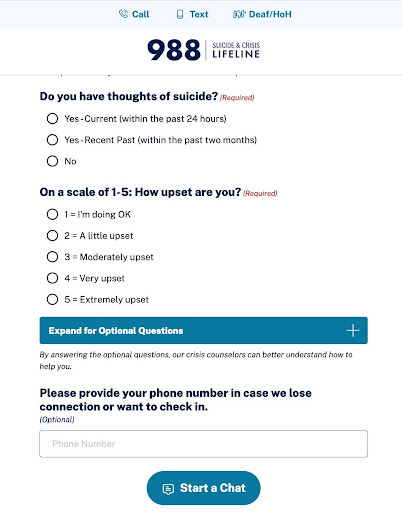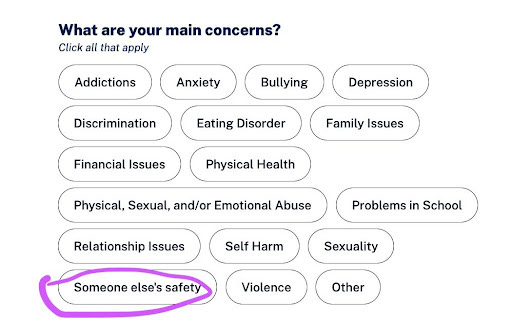TL; DR: There are steps that all of us can take to raise awareness around suicide, to help someone who is struggling, and to intervene when there is a risk of suicide. Read on to learn more about the different levels of prevention.
Content Warning: This post discusses the prevention of death from suicide. If you or someone you know is struggling, please know that there is help available. People can call, text 988, or chat at 988lifeline.org/chat in the U.S. For TTY (teletypewriter) Users: Use your preferred relay service or dial 711 then 988. Línea de Prevención del Suicidio y Crisis: 988
On June 30, 2025, I used 988 for the first time.
As a primary care clinician, I have given this number to patients and families and I have written about this resource many times. But on that particular Monday morning, one of my closest friends texted me, “I want to die.” And they had also texted me their plan.
My heart clenched. I hadn’t seen the text for over an hour. Was I too late?
I reached out as soon as I saw the text, letting them know they were not alone. I told them that I had felt similar hopelessness and that help was available.
I was 3,000 miles away and felt a rise in panic because I didn’t know the specific resources for their area. While on the phone with them, I started a chat on https://chat.988lifeline.org/
The skilled and compassionate human on the other end kept me calm and helped me help my loved one. They offered to do a three-way call if my loved one consented.
With 988’s help, we got through that crisis. And my friend now knows what resources exist. They know they are not alone. They know that they matter.


Let’s look more closely at what we all can do to help prevent suicide.
Suicide is a public health issue. It is one of the top 15 causes of death across the globe, a leading cause of death among young adults, and it is increasing among young people ages 15-24. In 2023, a person died from suicide once every 11 minutes.
With increasing awareness and interventions, we can all do our part to help prevent deaths from suicide.* Let’s look to three levels of prevention to guide our efforts.
🪂 Action in a crisis: what is the most immediate impactful help for a person who is at-risk, but has not yet tried to hurt themselves?
- Know the major risk factors: There are many, but some include mental health conditions like depression, chronic pain or illness, substance/alcohol use disorder, family history of death from suicide, and having access to weapons or medications/substances that could be used for self-harm. The World Health Organization (WHO) has a helpful fact sheet.
⚖️Health Equity Alert: expressions of suicidal intent can look different based on cultural background (i.e. depending on a person’s identity and upbringing, their risk factors, symptoms and protective factors can look different from others’). Learn more here.
- Talk to the person and listen to their story. Let them know that you are there for them and that while you may not be able to understand their experience, you are there to support them. Do not debate or question how they feel. Validate their experiences, feelings or thoughts that led them to this moment. It can be as simple as “I know what you have been going through is so painful.”
Note: As you learned from reading my experience above, being the support person can cause intense feelings of uncertainty of how to help, fear, and even panic. 988 has support for you as well: https://988lifeline.org/help-someone-else/ They gave me emotional support and practical steps to help my loved one.
- Ask questions about whether they are thinking about suicide. Do not be afraid to ask questions directly. This does not increase the risk of suicide. The Columbia Lighthouse Project has resources for how to ask these questions in many settings, including for friends and families. Some examples of questions include:
- How are you coping with what is happening in your life?
- Have you ever wished you would go to sleep and not wake up?
- Have you ever thought about suicide before?
- Have you ever tried to end your life?
- Do you have a plan for ending your life?
(These sample questions are from the Mayo Clinic and Columbia Lighthouse Project.
💫 Note: you don’t have to know how to do a thorough suicide assessment in order to be helpful and you can reach out for help from a trained person even if you are not sure how immediate your loved one’s risk is.
- If they are thinking about suicide, tell them about 988 (available en Español and English) (https://988lifeline.org/) or their state’s warmline. For TTY (teletypewriter) Users: Use your preferred relay service or dial 711 then 988. Línea de Prevención del Suicidio y Crisis: 988. If you are outside of the U.S., know what the local resources are and encourage professional help.
⚖️Health Equity Alert: Some folks from communities that have been historically marginalized or harmed by systems, may be afraid to use a national service, not knowing what to expect. Here is a video of what one can expect when using 988.
For people from Black communities, here is a Black-focused resource.
For people from the Queer community, here is the LGBT National Hotline: 888-843-4564
Find more resources below. Please share more resources in the comments if you know of them.
- If you are with the person in distress, you can call 988 or your local resources to see how best to help them. If your loved one is on the phone with you, you can do a three-way call with their permission.
🛟 Strategies for prevention of death from suicide with someone who has recently tried to end their life.
How can we help protect them from future self-harm?
- Have open and honest conversations about what did/did not happen. The person may or may not be ready to talk about it. Know that they also may be confused as to why they are in the hospital if they have been taken there.
- Remind the person that there is no shame or stigma in going to the hospital for medically needed care.
- Help them find a therapist, a support group, or local chapters of organizations like the National Alliance on Mental Illness (NAMI) or the American Foundation for Suicide Prevention (AFSP) who have experience supporting people after an attempt. If they would like to talk to someone about medication, encourage them to consider talking to a primary care or psychiatric clinician about it to see how it might help.
- Offer help with daily activities. Things can be overwhelming, especially if there are medical bills or other costs after a hospitalization. Helping with groceries or simple tasks can help decrease stress for the person who is recovering.
- Help the person after an attempt make a safety plan to stay safe and to have people they can reach out to if they need extra help.
✋ Lastly, let’s talk about prevention at the population level, looking upstream to the root causes.
At the community level, this can include campaigns that destigmatize mental health issues, community action for mental health, developing policies that look at limiting access to the main ways people use to end their lives (firearms are the most commonly used method, more than 50% according to the CDC), support of mental wellness, support for communities at-risk including Indigenous communities, elders, and LGBTQIA2S+, and school programs that focus on anti-bullying and social/emotional development.
At the individual level, we can:
- Be open about our own mental health status with our loved ones, colleagues, and neighbors. This destigmatizes mental health disorders and helps our loved ones know they are not alone
- Share support in person or on social media
- Get trained with the Substance Use and Mental Health Services Administration (SAMHSA)
- Volunteer at our local schools or senior centers
- Write to our local, state, and national leaders and legislators about
- Increasing access to trauma-informed mental health care
- Funding substance use disorder treatment programs
- Creating local crisis response teams to be dispatched during mental health crises
- Legislation to support and heal marginalized communities
- Learning about intergenerational and historical trauma (resources below)
- Joining the Diversity, Equity, Inclusion teams, if they still exist, at your place of work or asking that your employer create one, maybe creating or renaming it Belonging or Welcoming team
- See WHO’s LIVE LIFE implementation guide for suicide prevention strategies for all countries.
These action items are just a start.
❤️🩹 If you have lost someone to suicide or have survived a suicide attempt you may have feelings of shame, stigma, guilt, and intense grief. You are not alone.
Stay safe. Stay well. Stay connected.
Those Nerdy Girls &+
*We avoid using the word “commit’‘ as it implies criminal behavior. The phrase death from suicide is de-stigmatizing language.
Learn more here:
WHO’s Fact Sheet and LIVE LIFE Suicide Prevention Campaign:
Suicide Prevention – National Institute of Mental Health (NIMH) [archived link]
What to Expect – 988 Suicide & Crisis Lifeline
What to do when someone is at risk
Historical Trauma:
Trauma | The Administration for Children and Families.
TNG’s previous Post on 988: 📣Have you heard about 988? — Those Nerdy Girls
Evidence review: The primary prevention of mental health conditions =
Other phone lines and internet support:
Following the June 2025 ending of the dedicated “Press 3” option for LGBTQ+ youth on the 988 Suicide & Crisis Lifeline, several other organizations have stepped up for queer communities:
The Trevor Project: for LGBTQ+ young people (ages 13–24).
TrevorLifeline: Call 1-866-488-7386
TrevorText: Text “START” to 678-678
TrevorChat: An online instant messaging service available on their website
LGBT National Hotline: 888-843-4564
LGBT National Youth Talkline: 800-246-7743 (for ages 25 and under)
SAGE LGBT Elder Hotline: It is available in English and Spanish, with translation for over 180 languages.
Hotline: Call 1-877-360-5428
Link to Original Substack Post


